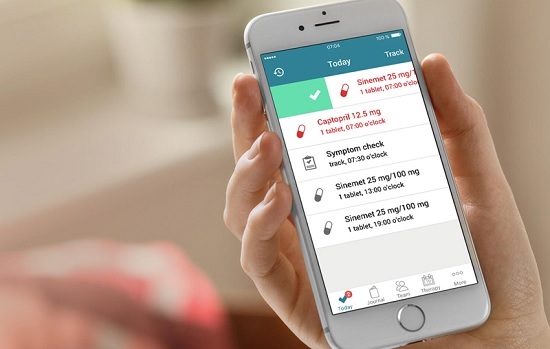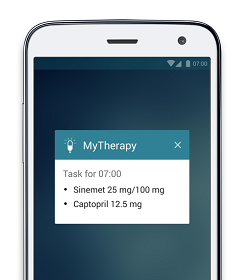Parkinson’s Disease? Move forward with Medication Adherence, Symptom Control, and Treatment with MyTherapy
With Parkinson’s Disease, You Need to Stick to a Strict Schedule Regarding Your Treatment. MyTherapy Can Help You with This. Find out More Below ...

Parkinson’s disease (PD) is a neurodegenerative disorder that affects dopamine-producing neurons in a specific area of the brain. The symptoms tend to develop slowly over the years and include tremors (mainly at rest), bradykinesia (slow movement), limb rigidity, balance problems, apathy, and depression. Life with Parkinson’s disease is therefore challenging. While there is currently no cure for PD, there are numerous treatment options available to help with symptom control. PD itself is not fatal, but the complications associated with the condition can be serious.
Therefore, adherence to treatment is absolutely essential if you have PD and want to have a good quality of life. If you work with your doctor, take medication responsibly, and do therapy; you can still live a good, active life. Adherence to medication and therapy isn’t always easy, so smartphone health apps - like MyTherapy - can motivate and help you adhere to your medication and therapy. User feedback from people living with PD indicate that MyTherapy has helped them immensely and improved their quality of life.
When it comes to chronic conditions, like Parkinson’s disease, it is absolutely essential to adhere to prescribed medication, attend doctors’ appointments, and make the necessary lifestyle changes. Adhering to medication for PD is particularly important in the early stages of the disease. By reminding you to take your various medications, MyTherapy - one of Europe’s leading medication and health tracker apps - offers valuable support in managing the disease. All you (or family members/ doctors) have to do is upload your treatment plan and the app will take care of the rest. Your alarm reminders and pop-up notifications will tell you what medication you need to take and when to take it. Furthermore, you can also make use of the app’s built-in digital health diary. This diary allows you to track your symptoms, any medication side effects, and record any important measurements. With this diary, you can easily monitor and discuss the course of your PD with your doctor, thereby ensuring that you and your doctor can find the best treatment regimen tailored to your needs. This makes MyTherapy an effective app, both for the early stages and later stages of Parkinson’s disease. You can also use the app to set daily health and exercise goals. Lastly, all the data you record in the app can be printed out in the form of a monthly health report, You can then share this with your doctor so that he/she can evaluate how you are doing on a month-to-month basis.
The app is easy to understand and has a simple user interface, meaning that patients of any age can tailor the app to their specific needs and benefit from the features of MyTherapy. Let MyTherapy help you understand your medications and help you stick to a schedule so that you can avoid any "off" periods due to skipping doses.
Parkinson’s Affects the Dopamine Levels
Parkinson’s disease is a progressive disease of the nervous system. It is characterized by the loss of nerve cells (neurodegeneration) in a part of the brain called the substantia nigra. Nerve cells in this part of the brain produce an important chemical called dopamine, which acts as a messenger between cells to control body movement. In Parkinson’s disease, the progressive neurodegeneration means that the amount of dopamine decreases. This leads to an imbalance between dopamine and other chemicals of the brain, which causes abnormalities in movement.
The causes for the neurodegeneration and the resulting dopamine shortage in Parkinson’s disease are unclear. It seems likely that several factors are involved in the condition. In some cases, Parkinson’s can run in families when faulty genes are passed on from parents to children. However, it is rare that Parkinson’s is inherited. Instead, environmental factors usually play a bigger role. These may include pesticides in farming or traffic pollution.
Parkinson’s disease is the most common type of parkinsonism, an umbrella term for conditions causing tremors, muscle rigidity, and slowness of movement. In other, rarer forms of parkinsonism, specific causes have been identified. For instance, some medications (e.g. antipsychotic medication) can cause drug-induced parkinsonism. Moreover, progressive brain conditions (e.g. progressive supranuclear palsy) or strokes can also be responsible for the symptoms of parkinsonism.
Parkinson’s disease is mostly an age-related disease and affects older people. It can, however, occur in younger adults, but only a minority of people will get Parkinson’s before the age of 50. The condition affects one in 500 people, which is about 127,000 in the UK. Men and women are equally affected.
Balancing Act: Signs of Parkinson’s Disease
PD is characterized by main symptoms and other associated symptoms. The main symptoms, which are also called motor symptoms, affect your movement and include tremors (shaking), slowness of movement, rigidity (stiffness), weakness, and balance problems. The rigidity is caused by an increase in muscle tension, especially in the neck and shoulders. Slowness of movement often occurs in the early stages of Parkinson’s and can affect various body parts. The uncontrolled contraction of antagonistic muscle groups is referred to as a tremor and usually affects the hands first. In addition, the sense of balance is often lost in the course of the illness and patients develop an unnatural bent over posture.
Other symptoms of Parkinson’s can affect physical, psychological, and mental health. These include:
- Bladder and bowel problems
- Eye problems
- Falls and dizziness
- Fatigue
- Skin and sweat problems
- Muscle and joint pain
- Speech and communications problems
- Swallowing problems
- Anxiety
- Dementia
- Depression
- Hallucinations
- Memory problems
Effectively Treating Parkinson’s
Parkinson’s disease is treated in different ways. One significant part of the therapy involves medication. Various drugs aim to restore the balance of chemicals in the brain. However, these drugs do come with side-effects and you will need to be monitored carefully by your doctor.
In recent years, there have been many significant developments in the treatments for PD. The earlier you begin your medication, the more effective it will be in the long-run. Most people with Parkinson’s will eventually take a drug called levodopa (Madopar, Caramet, Sinemet). It is a dopamine precursor, which means that it is absorbed by the cells in the brain and converted into dopamine. By increasing the levels of dopamine, levodopa improves movement problems and lessens stiffness and rigidity. Furthermore, the drug Sinemet includes a mixture of levodopa and carbidopa and is effective in reducing the side effects of levodopa.
Dopamine agonists are similar to levodopa, but have a slightly milder effect. They act as a substitute for dopamine in the brain and include bromocriptine, cabergoline, and lisuride.
Monoamine oxidase-B (MAO-B) inhibitors can be used as an alternative to Levodopa in the early stages of Parkinson’s. They block substances that break down dopamine, thereby increasing dopamine levels.
Additionally, patients may require catechol-O-methyltransferase (COMT) inhibitors. These prevent levodopa from being broken down by an enzyme called COMT. You can visit this webpage for a more comprehensive list of drugs used to treat PD.
In severe Parkinson’s cases, deep brain stimulation may be necessary. This involves implanting a pulse generator into specific areas of the brain (similar to a heart pacemaker). The pulse generator produces very small electric currents and stimulates the parts of the brain affected by Parkinson’s. This can ease the symptoms for many people.
Alternative treatment for Parkinson’s includes physiotherapy and speech therapy. Physiotherapy can relieve muscle stiffness and joint pain through exercise and movement. Speech and language therapy can help with swallowing difficulties and speech problems. The aim of these alternative treatments is to limit the disability.
If you would like more valuable info on PD (such as resources and support), you can visit www.parkinson.org.
Moving Forward with Your Mobility and MyTherapy
In order to manage Parkinson’s disease as effectively as possible, it is imperative that you adhere to prescribed instructions from your doctor. To do this, you need to create a schedule - and what better way than to use your smartphone. MyTherapy includes everything you need to manage your PD. With its reliable reminders for medication and appointments and built-in health diary, you can monitor your condition and ensure that you are getting the best out of your treatment plan. Furthermore, you can print out a monthly health report (in the form of graphs) of your logged data, which you can give to your doctor so that he/she can gain insight into how you are doing. Together, these features make MyTherapy a valuable companion in managing Parkinson’s disease and helping you with symptom control. Patients like Anja T. highly recommend the app: “Since I have been using MyTherapy, I hardly have to think about my treatment plan anymore – my mobile takes over that job for me now.”


